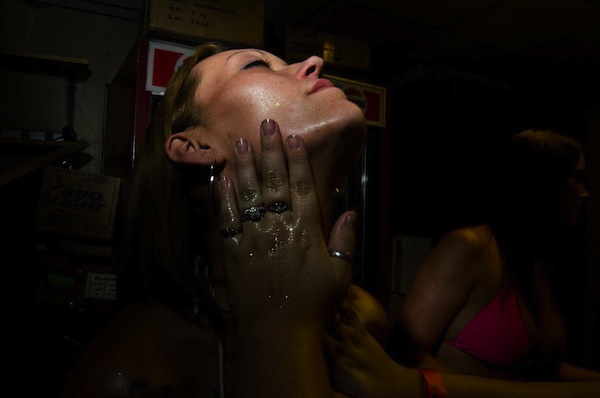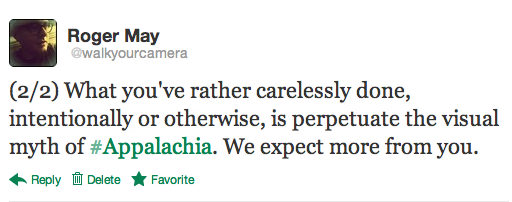 ©Stacy Kranitz / CNN Photos
On 7 May 2012, CNN published a series by photographer Stacy Kranitz from her body of work entitled "Regression to the Mean." The series, 16 images in all, caught my attention and raised a series of red flags. Admittedly, I'm hypersensitive when it comes to how Appalachia is, and has been, portrayed especially in mass media. So, before I was too quick to judge, I went to Kranitz's Web site to see for myself just what all of this was about.
©Stacy Kranitz / CNN Photos
On 7 May 2012, CNN published a series by photographer Stacy Kranitz from her body of work entitled "Regression to the Mean." The series, 16 images in all, caught my attention and raised a series of red flags. Admittedly, I'm hypersensitive when it comes to how Appalachia is, and has been, portrayed especially in mass media. So, before I was too quick to judge, I went to Kranitz's Web site to see for myself just what all of this was about.
Listed in her projects section, "Regression to the Mean" offered the following introduction:
Representing place is a complicated series of negotiations. How can the photographer demystify stereotypes, sum up experience, interpret memory and history.
Regression to the mean is a term used to define a phenomenon in statistical analysis. If a variable is extreme on its first measurement, it will tend to be closer to the average on its second measurement.
This concept outlines my process, which requires many visits in order to gain a photographic series of images that averages these extremes. I am initially drawn to stereotypes. Then I look to demystify these stereotypes only to find that they are rooted in some sort of reality. I do not exclude the stereotypical image from my representations, nor do I only seek it out. The resulting images are a regression to the mean and the mean is interwoven with both typical and atypical lives captured through controlled and chance operations.
Nothing is all one thing or its opposite. There are moments in time that you see a degree of continuity between these opposing forces. Ultimately the term Regression to the Mean articulates the flaws of representation. Flaws which I openly embrace.
The project is broken down into two sections; Old Regular Mountain and Don't Drop the Potato. The first section contains 77 images from her Appalachia travels. From these, CNN ran 16 images along with the following statement:
Life in Appalachia: ‘Regression to the mean’
Photographer Stacy Kranitz is drawn to people outside mainstream American culture. Last summer she traveled through West Virginia, Kentucky, Virginia and Tennessee for three months exploring the towns and the everyday lives of the people of Appalachia.
Kranitz, like traditional photographers of the past, injected herself into the lives of her subjects.
“The compulsion to explore and immerse myself in others’ lives is a desire deeply embedded inside me,” Kranitz said about her approach.
The set of images selected by CNN showed anything but "the everyday lives of the people of Appalachia." In fact, it wasn't even a very good representation of Kranitz's overal body of Appalachia work. After spending some time on her site looking through her images, I began to notice a sort of pattern CNN must have used when selecting photos for this feature. They skipped over image after image of "everyday lives of the people of Appalachia" and settled instead for the most common stereotypical images from our collective darkest preconceptions of this region. In short, they perpetuated the visual myth of Appalachia. The KKK and strippers?
As an Appalachian and a photographer, I wanted to hear Kranitz's take on CNN's edit of her work. I sent her an email.
On May 7, 2012, at 8:34 PM, Roger May wrote:
Stacy,
I just wanted to say I really enjoyed looking at your Web site and blog. Some of the images are just flat-out gorgeous. As an Appalachian and a photographer, I'm curious to get your thoughts on CNN's edit of your images here - http://cnnphotos.blogs.cnn.com/2012/05/07/life-in-appalachia-regression-to-the-mean/
Do you feel that the editorial staff did justice to your entire body of work in Appalachia? Some friends and I have had lengthy conversations about their edit of your images. Seems as though they gravitated toward the more stereotypical images of Appalachia. Not that I'm speaking ill of your images. You and I both know those people, places, things, exist. There's no denying it. Your project statement says, "I do not exclude the stereotypical image from my representation, nor do I only seek it out." However, it seems the good folks at CNN looked over four times as many images one could consider less like those that have perpetuated the visual myth of Appalachia. Or, bluntly, they chose to only seek those images out in your work in my opinion.
I'd love to hear your thoughts, and perhaps if you'd like, maybe even chat on the phone.
All the best,
Roger
She quickly replied to my email to voice her displeasure at the presentation of her work.
On May 8, 2012, at 12:54 AM, stacy kranitz wrote:
Hi Roger,
Thank you for taking the time to write to me. I am glad to hear that the work lead to a conversation with friends because I think talking about photography and representation are both important and valuable. I appreciate that you took the time to look at the work and call into question CNN's edit.
As you can imagined I am in a state of shock. I feel ashamed and humiliated for trusting CNN. I am stunned that they would take my work out of context. I spent a long time looking at their website before agreeing to show my work and in no way did I see any indication that they were subverting photographers work to lead to controversy that would provide greater visibility of their site. Still, I take responsibility for not knowing better.
I do not see what I have photographed as a look at "the everyday lives of Appalachian people" as CNN has claimed, nor is that written anywhere in the CNN interview questions I answered or on my website.
For the project I sought out the stereotypes and photographed them so that I could then offer a counter to them. That is what the project is about. It is meant to be a dialogue about stereotypes: the mythology they create, their value and their role in society and how they factor into the representation of place. It seemed the furthest from possible that CNN knowing my interest in seeking out and demystifying stereotypes would make an edit of only the stereotypes.
I made clear to the editors at CNN that I was in the very early stages of the project and was not willing to make any claim that my work accurately reflected the Appalachian region. But they chose to make it sound as though that was exactly what I did.
I think people are rightfully angry. I am disgusted to see the words "the everyday lives of Appalachian people" next to images of the KKK. That is a real insult to the region as is the reductive edit of my work and I understand why people are so offended by it.
But I feel at a real loss as to what to do about both my anger and the anger of all the people who wrote comments. I am not at all clear what and when is the right / best way to stand up to myself and when it is best to let things be. I chose not to comment on the CNN blog because I thought it best not to use the media outlet that originally misrepresented me as the place where I stand up for myself. I think it is important that I write to the editors that I worked with and let them know I am hurt but I have decided to wait a few days and let some of the emotion I feel subside. I have written individual emails to everyone who has written to me.
I would be interested to hear what you would do if you were in my situation especially knowing you are also a documentary photographer.
Thanks again for taking the time to write. You have some great work on your site. I will definitely check back in to see how things progress.
Best,
Stacy
Powerful words. Shock. Ashamed. Humiliated. Stunned. Disgusted. And reading through the comments section of the CNN photo blog, folks echoed those exact sentiments and more. However, the anger was directed more toward Kranitz than CNN. I tweeted to CNN Photos, asking for some sort of explanation as to why those specific images were chosen.
Since there was no response via Twitter, I emailed CNN at the address they listed on their photo blog, which also turned out to be unfruitful. In fact, I received an automatically generated email thanking my for submitting a pitch to them. Sure, it's a generic email response due to the sheer volume of submissions they get, I'm sure, but oh, the irony.
I still haven't heard from anyone at CNN's photo blog. Kranitz, however, has been in contact with them and addressed her concerns over their initial edit of her work. They agreed to change out some of the photographs in the original sequence. Kranitz emailed me yesterday evening and shared this:
I have written to CNN much of what I wrote to you. The photo editors at CNN responded and showed genuine concern for my desire to have the project presented in a way that was true to my intentions. While so much of the damage has already been done with so many people seeing the original sequence of images I appreciated that the editors where immediately responsive to my desires to change the edit to be more accurate to the project.
So, CNN agreed to change some of the images. You'll now notice the above stripper image is no longer online, however the KKK's burning cross remains. I believe the original set of 16 images including two KKK photographs. One of the interesting things about this is that in all 77 images in Kranitz's series on her site, there are only three KKK-related images and "somehow" two of those made it in the first published series by CNN).
She also writes, "It's been an exhausting few days and I hope that you and I can find a way to turn this situation into a dialogue about representation and stereotypes in Appalachia. This was my original intention and I want to believe that even through all of the missteps it is still possible."
Later today, she'll be featured at The Revivalist, a blog by Mark Lynn Ferguson dedicated to Appalachia (and one of my favorites). I'm looking forward to reading that conversation. Later, in part two of this post, I'll share some more thoughts about visual stereotypes of Appalachia as well as look at more images from Kranitz's series.




